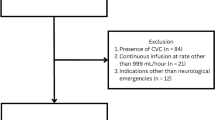Abstract
Breath-holding spells (BHS) are commonly observed in children as a result of an autonomic nervous system disorder triggered by crying, emotional distress, or pain. There are several types of BHS and cyanotic type is one of them. We encountered a case of 3-year-old girl who presented with a delayed adaptation period and BHS 2 weeks after an endoscopic third ventriculostomy (ETV). She experienced severe headache due to increased intracranial pressure (ICP) during the delayed adaptation period, which may have contributed to the onset of BHS. Management of BHS warrants treatment of the symptoms and removal of the causative factors; in our case, intensive pain control and resolution of the increased ICP after the adaptation period were effective. While BHS are usually described as a benign condition that improves spontaneously, we highlighted the importance of recognizing and monitoring atypical symptoms such as BHS in pediatric cases.



Similar content being viewed by others
References
Yamada S, Miyazaki M, Kanazawa H, Higashi M, Morohoshi Y, Bluml S, McComb JG (2008) Visualization of cerebrospinal fluid movement with spin labeling at MR imaging: preliminary results in normal and pathophysiologic conditions. Radiology 249:644–652
Bellotti A, Rapana A, Iaccarino C, Schonauer M (2001) Intracranial pressure monitoring after endoscopic third ventriculostomy: an effective method to manage the “adaptation period.” Clin Neurol Neurosurg 103:223–227
Hopf NJ, Grunert P, Fries G, Resch KD, Perneczky A (1999) Endoscopic third ventriculostomy: outcome analysis of 100 consecutive procedures. Neurosurg 44: 795–804; discussion 804–796
Nishiyama K, Mori H, Tanaka R (2003) Changes in cerebrospinal fluid hydrodynamics following endoscopic third ventriculostomy for shunt-dependent noncommunicating hydrocephalus. J Neurosurg 98:1027–1031
Yilmaz U, Doksoz O, Celik T, Akinci G, Mese T, Sevim Yilmaz T (2014) The value of neurologic and cardiologic assessment in breath holding spells. Pak J Med Sci 30:59–64
Leung AKC, Leung AAM, Wong AHC, Hon KL (2019) Breath-holding spells in pediatrics: a narrative review of the current evidence. Curr Pediatr Rev 15:22–29
Buyukgoz C, Mendez MD (2020) Breath holding spells. StatPearls, Treasure Island (FL)
Breningstall GN (1996) Breath-holding spells. Pediatr Neurol 14:91–97
Goldman RD (2015) Breath-holding spells in infants. Can Fam Physician 61:149–150
Tomoum H, Habeeb N, Elagouza I, Mobarez H (2018) Paediatric breath-holding spells are associated with autonomic dysfunction and iron deficiency may play a role. Acta Paediatr 107:653–657
Rathore G, Larsen P, Fernandez C, Parakh M (2013) Diverse presentation of breath holding spells: two case reports with literature review. Case Rep Neurol Med 2013: 603190
Kolkiran A, Tutar E, Atalay S, Deda G, Cin S (2005) Autonomic nervous system functions in children with breath-holding spells and effects of iron deficiency. Acta Paediatr 94:1227–1231
Guilleminault C, Huang YS, Chan A, Hagen CC (2007) Cyanotic breath-holding spells in children respond to adenotonsillectomy for sleep-disordered breathing. J Sleep Res 16:406–413
Acknowledgements
We thank the staff of the Department of Neurosurgery at Tokyo Women’s Medical University for their guidance and assistance in preparing this paper. Documented informed consent was obtained from patient’s guardians.
Author information
Authors and Affiliations
Corresponding author
Ethics declarations
Informed consent
Written informed consent for publishing of this manuscript was obtained from the patient’s guardians.
Conflict of interest
The authors declare that they have no conflict of interest.
Additional information
Publisher's Note
Springer Nature remains neutral with regard to jurisdictional claims in published maps and institutional affiliations.
Supplementary information
Below is the link to the electronic supplementary material.
Supplementary file1 (MP4 55957 KB)
Supplementary file2 (MP4 150991 KB)
Rights and permissions
About this article
Cite this article
Chiba, K., Aihara, Y. & Kawamata, T. Breath-holding spells after endoscopic third ventriculostomy in a post-ventriculoperitoneal shunted patient. Childs Nerv Syst 38, 813–816 (2022). https://doi.org/10.1007/s00381-021-05247-z
Received:
Accepted:
Published:
Issue Date:
DOI: https://doi.org/10.1007/s00381-021-05247-z




